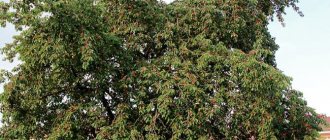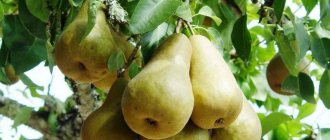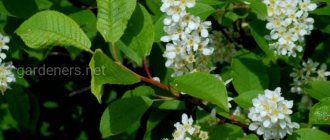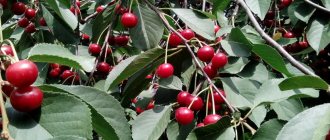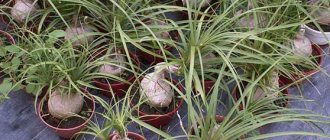What does a cherry look like?
Cherry is a deciduous fruit tree. Its active fruiting usually begins at 4–6 years and lasts about 20 years.
cherry tree
An adult cherry tree is a tall, spreading tree with an ovoid or cone-shaped crown. In comfortable conditions it can grow up to 15 m, but usually the height is 4–5 m. It is distinguished by the rapid growth of shoots, especially at a young age. The color of the bark is brown or reddish, sometimes silver, with clearly visible stripes. The shoots are covered with small scales.
What kind of leaves does a cherry tree have?
The leaves are light green, ovate, obovate or elliptical in shape, shortly pointed with a serrate edge. Petioles up to 16 cm long. The leaf blade is wrinkled.
How cherry blossoms
This crop blooms earlier than other stone fruits. In Central Russia, the flowering period occurs at the end of April - beginning of May. The flowers are white, five-petaled, bisexual, with numerous stamens and one pistil. The plant is self-sterile and requires pollinating neighbors to bear fruit.
It is pollinated by bees and is a valuable honey plant.
Cherry ripening time
The timing of fruit ripening strongly depends on the region of growth. The difference in flowering and fruiting of the same variety in different climatic conditions can be up to 1 month. The early ones in the south produce a harvest already at the beginning of May, but usually the fruiting of cherries begins at the end of May and ends in August for the latest ones.
When do cherries produce their first harvest?
Most cherry varieties are early-bearing and can produce the first berries already 4 years after planting. Some begin to bear fruit later, at 5–6 years. The rate of early fruiting strongly depends on the growing conditions; if the place is chosen incorrectly, the plant may not begin to bear fruit.
Features of cherries
The cherry differs from its closest relative, the cherry, by the presence of one powerful trunk, lighter leaves and large size. There are some nuances in growing this crop. Its root system is powerful and well developed. There is only one tap root, but there are quite a few horizontal ones. The depth of their occurrence does not exceed 0.2–0.5 m. The proximity of the roots to the surface makes any agricultural work in the root zone impossible, otherwise there is a very high chance of destroying the tree.
This culture is more demanding in terms of where it grows; it does not tolerate proximity to groundwater. To bear fruit, it definitely needs a large amount of sunlight and the absence of cold wind. It will not do well in swampy lowlands, on clay soils or in close proximity to other trees.
The advantage of growing cherries is that they begin to bear fruit earlier than all other stone fruit crops. However, it must be borne in mind that the crop can be completely destroyed by birds, which love these berries more than any other fruit. Therefore, it is imperative to take measures to protect against birds.
Where do cherries grow?
The traditional regions for growing this crop are the south of Russia: Krasnodar region, North Caucasus, Crimea. However, thanks to breeding work, the cultivation boundaries were significantly expanded. Now some varieties grow well even in the Moscow region, and with proper care, these fruit trees can be grown even in the Urals and Siberia.
For planting, you need to choose a sunny, well-lit place with a groundwater level no higher than 2 m. The planting site should be protected from drafts and north winds. The distance from neighboring trees or buildings should not be less than 3 m.
Since cherries do not pollinate on their own, seedlings are usually planted in groups for cross-pollination. 3 m is also left between neighboring seedlings so that the trees do not compete with each other. An important condition is that there should be no other crops between neighboring trees. For example, if you plant an apple tree between two cherries, the yield will drop by half.
Cherry grows well on light loamy soils. Heavy clay soils are not suitable for growing this crop. It will grow well on the southern slopes of gentle hills, away from tall buildings and structures.
Growing and caring for cherries
Planting of seedlings can be done in spring and autumn. The main thing is not to get caught in the cold. It is worth taking seriously the choice of landing site. It is best to produce it in places where the tree will be protected from the winds (near fences, in the vicinity of other trees).
Cherries cannot be planted in the shade. When planting, the soil should be watered and mulched. To combat coccomycosis, it is recommended to plant lilies of the valley around the trunk.
For the most part, cherries are drought-tolerant, but in particularly dry areas it is worth watering the tree periodically. Herbicides are used to prevent weeds. Fertilize should be done in the spring, in late April - mid-May.
In flat and particularly windy areas, most gardeners resort to insulating cherries for the winter. It is necessary to cover the cherries before the first snow.
Not everyone knows how to prune cherries correctly. Although the tree grows quickly, its ability to form shoots is weak. Therefore, during the process of crown formation, it will be useful to leave 4-5 branches for each tier.
The inter-tier distance is permissible up to half a meter. Active pruning should be carried out in the first years of seedling growth. After the start of fruiting, it should be stopped and carried out only for sanitary purposes (getting rid of old, dry branches). Proper and timely pruning will help in creating the exact shape of the tree and will make harvesting easier.
What work needs to be done in the fall to prepare fruit trees for winterPlanting and replanting trees in autumn: recommendations from experienced gardeners
What are the benefits of pomegranate for health and immunity?
Systematization of cherry varieties by ripening time
In total, there are three main groups into which all varieties of cherries are divided according to ripening time. These are early (late May-early June), mid-season (late June-early July) and late (late July-early August).
Early cherries: photos, varieties, description
Early ripe cherries can delight the gardener with the taste of ripe berries already at the end of May. Here are the most common early ripening varieties:
Valery Chkalov. Quite common, ripens in early June.
The berries are large, weighing 7–9 g on average, and burgundy in color. Productivity – 50–60 kg per mature tree.
Melitopol early. Ripens in early June.
The berries average weight 6–7 g, dark red. Productivity is about 50 kg per tree. The fruits are universally used, suitable for home canning and for fresh consumption.
Mayskaya. Ripens in late May–early June.
An exclusively dessert variety, suitable only for fresh consumption. The berries are bright red, small, weighing 3–4 g. Productivity from one tree is up to 40 kg.
Homestead. Very popular, ripens in early June.
The berries are yellow with a bright blush. Their average weight is 5–6 g, the total yield is up to 85 kg. The fruits tolerate transportation well and can be used both for fresh consumption and for canning.
Mid-ripening cherries
Mid-season varieties include varieties that ripen from mid-June to mid-July. As a rule, they are all universal in their purpose, have good taste and have good transportability. Here are some of the representatives of this group.
Revna. The berries are dark red in color and ripen by mid-July.
The average fruit weight is 5–5.5 g. Resistant to cracking even in high humidity conditions. A very popular variety due to its high winter hardiness. Productivity is high.
Fatezh. No less popular, grown not only in the European part of Russia, but also beyond the Urals.
The berries are small, 4.5–6 g, pale yellow with a beautiful blush. The average yield is about 30 kg per tree; with good agricultural technology and a favorable climate, it can be increased by 1.5–2 times. A universal variety with good transportability.
Vasilisa. One of the largest-fruited varieties. The weight of berries can be from 11 g and above.
The yield is about 30 kg per tree, but with proper cultivation it can reach up to 50 kg or more. The variety is also good because the first berries can appear on the tree in the second year after planting. Versatile, good for any use. Its magnificent appearance, combined with good taste and resistance to transportation, makes it one of the most commercially attractive.
Surprise. It has good resistance to frost and perfectly tolerates heat and drought.
The berries are dark red, large, weighing up to 10 g. The yield is high. Universal purpose.
Late varieties of cherries
Late varieties, as a rule, have good taste and aroma, and due to their thicker skin, increased resistance to transportation. Here are some of them.
Tyutchevka. A well-known and beloved variety by many. Ripens at the end of July.
It has good performance in all respects; its only drawback can be considered the tendency of the berries to crack in excessively wet weather. The berries are medium in size and weight (about 7 g), the yield is high.
Regina. Quite a productive variety and resistant to frost, heat and disease, the result of the work of German breeders. Ripens at the end of July, or later in unfavorable weather conditions.
The fruits are dark crimson in color, quite large, 8.5–11 g, and have a universal purpose. Productivity can reach 40 kg from one tree and above.
Bryansk pink. Ripens in early August.
The berries are small, their average weight is 4.5–5.5 g. A universal variety, suitable for canning or fresh consumption. The taste of the berries has a noticeable bitterness, which is assessed negatively by many.
Advantages of late-ripening varieties
To obtain a bountiful harvest, cherries are selected taking into account the description of the variety and the climate in the growing region. For central Russia, varieties with the best frost resistance are suitable. In the southern regions, heat-loving crops are grown. Sweet cherries differ from cherries in their early ripening period. The harvest is harvested in early June. To enjoy delicious sweet berries all summer long, many gardeners plant late varieties.
Compared to other varieties, late cherries have several advantages:
- they produce a large harvest;
- the berries are juicy, sweet and tasty;
- they have high frost resistance.
Late-ripening varieties are planted in regions with cool climates. The ripening of the harvest of such cherries occurs in the second half of summer and early autumn, when the likelihood of unexpected frosts is minimal.
Self-fertile cherry varieties
The term “self-fertility” is practically not applicable to most cherry varieties. This plant does not pollinate itself and requires nearby pollinating trees for normal fruiting. However, many still use this characteristic when describing.
What does “self-fertile cherry variety” mean?
A tree that bears 15–40% of the total number of flowers is considered self-fertile. If the number of ovaries is less than 4%, the plant is considered self-sterile. Intermediate values allow the variety to be called partially self-fertile.
Numerous experiments carried out with various varieties of cherries did not reveal self-fertility above 35%. The main mass has a significantly lower percentage (5–10), which allows us to speak of them only as partially self-fertile.
Self-pollinating cherry varieties
There are not many varieties of cherries that can produce crops without cross-pollination. Here are some of them:
- Bereket.
- Valery Chkalov.
- Horny goat weed.
- Danna.
- Pridonskaya.
- Homestead yellow.
The tree is weakened
A tree may not bear fruit due to weakening or depression, which is manifested by the following symptoms:
- small increase per season;
- gum flows from the branches and trunk;
- branches do not form on the branches;
- other symptoms indicating a weakening of culture.
Such cherries are capable of blooming, but will not bear fruit. This can be caused by poor soil, close proximity to groundwater, or planting too deep. In excessively acidic soil, cherries will produce a small harvest. In shade and marshy areas, harvests will also be poor.
Pollinator varieties for self-fertile cherries
Most cherry varieties require cross-pollination to set fruit. Any other flowering at the same time can be suitable for this. It's enough just to plant them next to each other.
What is a “self-sterile cherry variety”
Most cherry varieties are self-sterile, meaning they cannot pollinate themselves. Moreover, entire groups of varieties can be self-sterile. Therefore, to obtain a harvest, the presence of a pollinator is a prerequisite.
How to choose the right pollinator variety
To guarantee a harvest, it is recommended to plant at least three different varieties of cherries that coincide in flowering time. Iput is most often used as a pollinator; it is a fairly universal species that coincides in flowering time with many others.
Reviews
Ivan, 33 years old:
The Revna cherry tree grows in my garden and bears fruit well. To do this, I planted another pollinator variety on the site in advance. The plant is undemanding in care. If you do not overfill it, the berries grow dense and juicy.
Marina, 40 years old:
I planted Tyutchevka cherries. I am completely satisfied with this variety. It is very productive and produces large fruits. The berries are kept fresh for a long time and are suitable for canning and cooking.
In order to enjoy fresh cherries longer, when choosing a variety, they are guided by the time of picking ripe berries. The shelf life of the fruit does not play a decisive role. Growing late-ripening varieties allows you to harvest cherries before the beginning of autumn, when the mass harvest of this berry has already been completed.
Classification of cherry varieties depending on tree height
The cherry tree itself is quite tall. However, such a high crown is inconvenient to work with, it is impossible to trim it, and the upper tier of fruits is guaranteed to go to the birds. Therefore, more and more gardeners give preference to low-growing trees, growing them on a dwarf rootstock or forming it in the form of a low bush.
Dwarf cherry
An undoubted advantage of dwarf trees is the ability to completely cover them for the winter, thanks to which winter hardiness can be significantly increased. Such trees can be planted both for harvest and for decorative purposes.
The most famous varieties of dwarf cherries are:
- Winter pomegranate.
- Saratov baby.
Low-growing varieties of cherries
Low-growing trees are 2.5–3 m high. These varieties include the following:
- Baby.
- Fatezh.
- Original.
- Crying.
Currently, breeders from different countries are conducting research in this area. Using radiation suppression of the gene for tall stature, Canadian scientists obtained clones of the varieties Compact Lambert and Compact Stella with a low crown.
Medium-sized varieties of cherries
Most formed trees are 3.5–5 meters high. This is a standard height that allows you to work with the crown using various devices (ladders, stepladders, etc.). Medium-growing varieties include:
- Tyutchevka.
- Here we go.
- Leningradskaya black.
- Revna.
- Ovstuzhenka.
- Melitopol early.
- Italian.
Tall varieties of cherries
Tall varieties can fully realize their fruit potential. However, working with such a high crown is quite inconvenient; processing and harvesting takes a lot of time. Tall trees are usually grown in the southern regions of the country, without limiting the height of the trunk and performing only sanitary pruning.
The tall varieties are:
- Bigarro yellow.
- General's.
- Drogana yellow.
- Krasnodar early.
- Large-fruited.
- Leningrad yellow.
- Leningradskaya pink.
- Homestead yellow.
- Franz Joseph.
- Amber.
Planting late varieties
In Siberia and other regions with harsh climates, cherries are planted in the spring. In the southern regions, autumn planting in September is preferable. Then, before the onset of cold weather, the seedling has time to take root well, but the growing season does not begin. If the optimal time is missed, planting is postponed to spring. For the winter, the seedlings are placed in a shallow trench at an angle of 45° and covered with earth. To protect against freezing in winter, snow is regularly covered. Seedlings are protected from the sun with sheets of plywood or agrofibre. Polyethylene is not used to prevent damping off.
Advantages of planting cherry seedlings in the fall:
- there is no need for frequent watering, since it rains often;
- seedlings remain fresh for a long time, and the presence of possible infections can be easily determined by their condition;
- large selection of seedlings.
Plants on the rootstock are selected for planting. They have a slight bend and thickening slightly above the root collar. Also, the tree must have a central conductor. As it grows, it forms a central trunk. In the absence of the main conductor, the plant turns out to be very overgrown. The crown of such cherries often breaks under the weight of the fruit. Suitable for planting are seedlings 1-2 years old, with a flexible root system no less than 15 cm long. Before planting, damaged roots are removed and branches that are too long are cut off. The roots are then placed in water for 10 hours to moisturize.
For planting, choose a well-lit place, protected from the north wind. Low-lying areas with high groundwater are not suitable for cherries. The soil should be loose, sandy loam or loamy. The selected area is dug up, tearing out weeds and leveling with a rake. Make holes to a depth of 80 cm and up to 90 cm in diameter at intervals of 4 to 5 m. A nutrient mixture is added to each:
- 30 liters of humus;
- 1 liter of wood ash;
- 200 g superphosphate;
- 100 g of potassium sulfate.
Advice!
If there is a lot of clay in the soil, pour 1 bucket of sand into each hole. For sandy soil, add the same amount of clay. Nitrogen fertilizing is not used to prevent too rapid growth.
The soil mixture is mixed together with fertilizers, forming a small mound. The seedling is placed vertically in the hole, straightening the roots. The root collar is placed 3 cm above the soil surface. A peg is stuck nearby for support. The empty space is filled with fertile soil. From time to time the seedling is shaken to compact the soil. Having filled the hole halfway, pour in 10 liters of water. Then add more soil and compact it well.
The plant is tied to a support. Stepping back 30 cm from the trunk, make a ditch in the shape of a circle. Another 10 liters of water are poured into it. The tree trunk circle is mulched with compost or sawdust. When the soil settles, soil is added after a few days. After planting, the plant requires almost no care. To protect against rodents, the trunk is whitened and wrapped in burlap. In winter, snow is thrown on to protect the seedling from the cold. Twice a month, water the cherries with 1-2 buckets of water.
Separation of cherry varieties according to taste characteristics
Cherry fruits contain sugar and organic acids, depending on the concentration of which the taste of the berries will vary from sweet and sour to sweet. Sweeter ones are used fresh, for the production of juices and in winemaking; berries with sourness are often preserved by adding one or another percentage of sugar.
Which cherries are the most delicious and sweet?
There are no comrades for taste and color, so the most delicious cherries probably do not exist. Among the varieties that have the highest tasting rating for taste, the following can be distinguished (table).
| Variety | Tasting score (out of possible 5 points) |
| Bryanochka | 5 |
| Revna | 4,9 |
| Tyutchevka | 4,9 |
| Gronkavaya | 4,8 |
| In memory of Chernyshevsky | 4,8 |
| Poetry | 4,8 |
| Pink pearl | 4,8 |
| Adeline | 4,7 |
| Homestead yellow | 4,7 |
| Pink sunset | 4,7 |
| Teremoshka | 4,7 |
| Red hill | 4,6 |
| And the way | 4,5 |
| Ovstuzhenka | 4,5 |
| Raditsa | 4,5 |
| Rechitsa | 4,5 |
| Fatezh | 4,5 |
The sweetest are Yaroslavna and Ovstuzhenka, having 14.2 and 13% sugar content, respectively.
Large cherry
Undoubtedly, the large size of the fruits always pleases the gardener's eye. There are also record holders among the cherry varieties. Such large-fruited ones include those that have a fruit weight of 7 g and above. Here are some of them:
- Annushka (9–10 years old).
- Ox heart (7–10g).
- Vasilisa (11–14 g).
- Friendship (10–11 years old).
- Donetsk beauty (7–10 g).
- Italian (7-8 years).
- Folk (7–10 g).
Important! The size of the fruit greatly depends on weather conditions and the condition of the tree. On unkempt cherries, the fruits become very small.
Popular varieties of cherries
The popularity of a particular cherry variety is often dictated by the climatic conditions of the region, and not by the preferences or wishes of the gardener. Therefore, frost-resistant varieties such as Revna, Iput, Fatezh, Ovstuzhenka, Tyutchevka are popular in the Central region and the Volga region. These same varieties are preferred by gardeners in Siberia and the Urals.
In more southern regions the choice is wider. This crop is grown there not only for personal consumption, but also for commercial purposes. Therefore, preference is given to large-fruited varieties with good resistance to transportation: Yaroslavna, Krupnoplodnaya, Annushka, Druzhba, Regina, etc.
The best early varieties
Gardeners are in particular demand for early plants. The appearance of berries can be expected from the end of May, beginning of June. Early-fruiting varieties are classified by yield, berry size and type of cultivation. Our team analyzed the reviews of twenty participants and based on this we collected the best options in this category.
And the way
As confirmed by reviews, the Iput cherry variety is resistant to cold and produces large volumes of berries. The tree grows up to 6 meters, so the distance between plants should be at least 3 meters. Cherry of this variety is demanding of sunlight, but can take root in different climatic conditions.
In the photo Iput is born
This is a good option both for the Moscow region and for the Urals. The fruits have the most delicate pulp and dark red shades. Sweet cherries have moderate sweetness and slight acidity.
Fruitful varieties of cherries
Do not forget that the yield of a tree largely depends not on the variety, but on the growing conditions: climate, soil composition, regularity of fertilizing, watering. Affects the yield and the method of pruning. With good care, the number of berries collected from a tree can exceed the average by several times. Among the varieties that consistently produce high yields, the following can be noted:
- Farewell.
- Yaroslavna.
- Tyutchevka.
- Cordia.
- Daibera black.
- Dzherelo.
- Franz Joseph.
- Donetsk beauty.
New varieties of cherries
Selection work does not stand still, and new specimens appear quite regularly. Some promising varieties that have recently appeared include the following:
- Madonna.
- Caucasian improved.
- Morning of Kuban.
- Sashenka.
- South.
- Ruby Kuban.
- Black eyes.
- Velvet.
- Enchantress.
- Contrasting.
- Announcement.
- Poppy.
- Scarlet.
All these varieties are the result of the work of domestic breeders, and it is possible that in the near future many of them will take their place in the gardens of our country.


